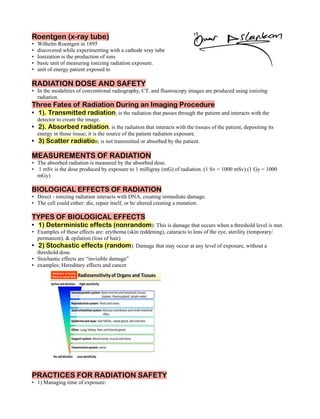
Roentgen (x-ray tube) .pdf
- 1. Roentgen (x-ray tube) Wilhelm Roentgen in 1895 • discovered while experimenting with a cathode xray tube • Ionization is the production of ions • basic unit of measuring ionizing radiation exposure. • unit of energy patient exposed to • RADIATION DOSE AND SAFETY In the modalities of conventional radiography, CT, and fluoroscopy images are produced using ionizing • radiation. Three Fates of Radiation During an Imaging Procedure 1). Transmitted radiation; is the radiation that passes through the patient and interacts with the • detector to create the image. 2). Absorbed radiation; is the radiation that interacts with the tissues of the patient, depositing its • energy in those tissue; it is the source of the patient radiation exposure. 3) Scatter radiation; is not transmitted or absorbed by the patient. • MEASUREMENTS OF RADIATION The absorbed radiation is measured by the absorbed dose. • 1 mSv is the dose produced by exposure to 1 milligray (mG) of radiation. (1 Sv = 1000 mSv) (1 Gy = 1000 • mGy) BIOLOGICAL EFFECTS OF RADIATION Direct - ionizing radiation interacts with DNA, creating immediate damage. • The cell could either: die, repair itself, or be altered creating a mutation. • TYPES OF BIOLOGICAL EFFECTS 1) Deterministic effects (nonrandom): This is damage that occurs when a threshold level is met. • Examples of these effects are: erythema (skin reddening), cataracts to lens of the eye, sterility (temporary/ • permanent), & epilation (loss of hair) 2) Stochastic effects (random): Damage that may occur at any level of exposure, without a • threshold dose. Stochastic effects are “invisible damage” • examples; Hereditary effects and cancer • PRACTICES FOR RADIATION SAFETY 1) Managing time of exposure: •
- 2. 2) Increasing the distance from the source: • 3) Using appropriate shielding materials: • DOSIMETER Dosimeters are devices used to measure the amount of energy deposited by ionising radiation. • ACUTE RADIATION SYNDROME The sequence of events that lead to death within days or week following high levels of radiation exposure. • Four periods • 1) Prodromal period; The immediate response to radiation that includes signs and symptoms of radiation • sickness.(minutes up to several days) 2) Latent period; The time after exposure during which there is no sign of radiation sickness and is a time • of apparent well being that may be mistakenly seen as early recovery.(few hours/few weeks. ) 3) Manifest illness; The actual manifestation of illness caused by the radiation exposure.(last from hours up • to several months. ) • 4) recovery Or death (several weeks up to two years.) • The three classic ARS Syndromes are: 1) Bone marrow syndrome; syndrome will usually occur with a dose between 0.7 and 10 Gy (70 – 1000 • rads 2) Gastrointestinal (GI) syndrome; Lethal syndrome that is caused by doses from 10 to 50 Gyt or 1000 • to 5000 Rad and occurs within a few days 3) Cardiovascular (CV)/ Central Nervous System (CNS) syndrome: Lethal syndrome that is • caused by doses above 50 Gyt or 5000 Rad and occurs within hours RADIATION CARCINOGENESIS is a major concern associated with radiation exposure. • radiation- induced cancers at doses of 500 mSv (millisievert). (1 mSv = 0.001 Sv). •